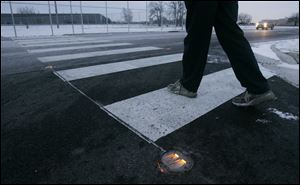
Lighted crosswalk aids pedestrians in Perrysburg
1/6/2010
Six arrays of bright-yellow, light-emitting diodes embedded in the pavement flash and flicker, as do alternating LED clusters on pedestrian crossing signs facing traffic on either side of the street. The display continues for 25 seconds, providing what should be ample time for pedestrians to cross Fort Meigs Road.
Push the button at either end of the Fort Meigs Road crosswalk at Coe Court in south Perrysburg, and the street comes alive with light.
Six arrays of bright-yellow, light-emitting diodes embedded in the pavement flash and flicker, as do alternating LED clusters on pedestrian crossing signs facing traffic on either side of the street. The show continues for 25 seconds, providing what should be ample time for pedestrians to cross Fort Meigs.
Surely the lights catch the attention of even the most distracted driver approaching the crosswalk, which links a subdivision to the west with ball fields to the east.
That, of course, is exactly the point.
"It's something you put in areas where you don't normally expect to see a crosswalk," City Engineer Doug Dariano said, adding that the concept is especially useful at locations that don't already have traffic lights.
Mr. Dariano said he first observed a light-up crosswalk while on active duty with the Navy at Pearl Harbor, Hawaii.
He was out for a pre-dawn jog along a road near the base "when all of a sudden, these lights started flashing in the road" - a fellow jogger had come up to a crosswalk along the route and pressed the button.
The city engineer came back from Hawaii thinking about where that technology might find a home in Perrysburg, and the widening last year of Fort Meigs, from two lanes to three, south of Eckel Junction Road, presented a perfect opportunity.
Mr. Dariano said his only reservation about the system pertained to potential snow-plowing damage, but he checked with authorities in Cleveland and Columbus who had installed the lights and "got a big thumbs-up." The embedded LEDs are recessed into the pavement, just like lane-marking reflectors, so plows don't hit them.
The system was turned on when Fort Meigs Road reopened to traffic on Dec. 3. Before the street's widening, Service Director Jon Eckel said, there had not been an official crosswalk at Coe Court, so it was appropriate "to go a step beyond the norm and put in something people will really notice."
Kelley Thompson, who lives nearby on Coe, said the LEDs are certainly noticeable, though she hadn't seen many pedestrians using the crosswalk during the past month - presumably because of cold weather. During the warmer months, she said, the ball fields are used mostly by adults "but high-school kids do walk back and forth sometimes."
"The traffic does go pretty fast, especially on the township [northbound] side," Ms. Thompson said. She also admitted having walked to the corner one day to "punch the button to see what it did."
Mr. Dariano said there are several other "pretty good candidates" for light-up crosswalks elsewhere in Perrysburg, and officials from several other suburban Toledo communities said they, too, would consider such installations.
Rodney Shultz, the deputy city engineer in Oregon, said crosswalks near Fassett School on Starr Avenue could become so equipped through the state Safe Routes to School program.
"Getting across there is an issue. That's one spot we've thought about," Mr. Shultz said.
Another is a crosswalk on Cedar Point Road at the BP refinery, he said.
The refinery recently added some signs there, and asked the city to install a blinking light to enhance the warning. But Mr. Shultz said continuously blinking lights' value is debatable.
"If it's flashing all the time, it loses its impact, because people start to ignore it," he said.
The notion of pedestrian-activated warning devices at crosswalks is hardly new. London has long had crosswalks with pole-mounted lights at either end that flash when a pedestrian presses a button.
But in the United States, crosswalk lights have typically been in the form of standard traffic lights that go from green to yellow to red when triggered. And besides being expensive, such traffic lights cannot legally be installed without elaborate traffic studies, as supporters of a signalized crosswalk near Sylvania's McCord Junior High School were told last year.
Jeff Ballmer, Sylvania's service director, said the use of a light-up crosswalk like the one now in Perrysburg "could be one of the things that comes up" during a Safe Routes to School study now under way for McCord and three other Sylvania schools.
Meanwhile, Bedford Township Supervisor Walt Wilburn said he planned to take a look at Perrysburg's installation after hearing a description of it.
"It sounds like something that would definitely fit the bill here," Mr. Wilburn said, noting that Bedford has been building a lot of sidewalks lately in its central village area.
Mr. Dariano said the Fort Meigs Road installation cost $30,000, which includes the lights, special signs, wiring, and a solar collector that will provide all the necessary electricity.